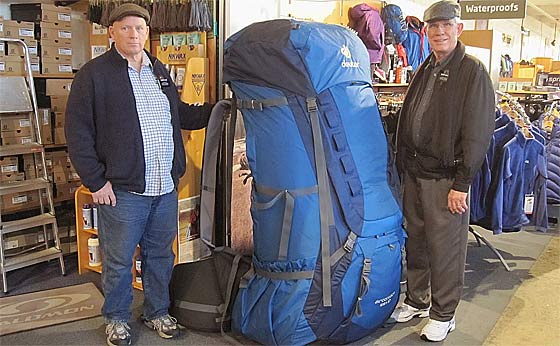72 Hour Bag Emergency Kit Organized Into Categories

Found the photo above online – couldn’t resist – world’s largest 72 hour bag / backpack emergency kit?
While it can be fun to pack your own 72 hour emergency kit (and to modify it now and again), don’t lose sight of the various categories for ‘the stuff’ inside…so that you ‘cover all the bases’ for its particular function and purpose.
What Is A 72 Hour Bag, and Why?
Let me rewind for just a second. What is the purpose of a 72 hour emergency kit? The answer may be a bit different for everyone. But the general purpose is to provide emergency preparedness supplies to assist in your survival and well-being for at least several days during a time when you might need it.
There are all sorts of purposes, each tailored their own way. Examples include EDC (every day carry), GHB, (get home bag), BOB (bug out bag). You might simply put one together to include on a hunting trip, or fishing, or tucked away in your ATV 4-wheeler, or snowmobile… A kit while on a hiking expedition. Camping. For in your vehicle. You get the idea.
Building such bags may sound crazy to most, but in an emergency AKA fire / flood / earthquake / hurricane / and so-on, they sure make sense…..
Katrina – I remember seeing the long LONG lines of traffic leaving AND those that could not get out and died, sure would be nice to be in front of that debacle because ya were organized and had a BOB.
I personally have every intention of Bugging-In, BUT, there are thousands of reasons ya may have to skedaddle if need be. Hence it’s called “being prepared”.
~ NRP, commentor on Modern Survival Blog
Categories Of Items Within A 72 Hour Bag Emergency Kit
I like the concept of putting one together while thinking about categories. You might conceptualize a 72 hour bag, of sorts. What might you put inside? Well, first do some thinking and decide on the categories of items that you would put inside. This is where it depends on your purpose.
The fun thing about any survival kit is that you can tailor them to specific needs, specific scenarios, and specific methods of carry and travel. You might put a small lightweight kit together to easily carry during a day-hike. Perhaps a larger 72 hour bag that’s kept in you vehicle. You might also put together a BOB kept in a closet at home specifically for an emergency evacuation or bug-out. Maybe one to take with you when you fly somewhere (business or personal trip). The sky’s the limit to your own intended uses.
If you think in terms of preparedness categories, it might be easier to put it all together without forgetting something important. It might also make it easier to organize and pack in such a way that is more convenient.
For example, the individual items of the fire-starter-kit within each of my overall emergency kits are kept in one place, pouch, or Ziploc bag within the kit itself. It’s all together that way. I know that if I grab that Ziploc, all my fire-starter stuff is in there, instead of strewn in various places in a backpack (for example).
The First Aid Kit portion of the overall 72 hour kit is also similarly kept in it’s own Ziploc (love the Ziploc’s for the waterproofing aspect too).
Maybe a category of items won’t fit in a Ziploc. That’s fine. But the idea here is to think in terms of a category, and then decide what you need in that particular kit to fulfill your needs in that category.
Multiple Kits
I think most of us probably have multiple “Kits” dependent on where we keep them. I have a Bin in my truck with a variety of supplies that includes things like tools, work gloves and boots, wool blanket, case of bottled water. As well I have a small school or work style backpack as my get home bag. Basically a change of clothes, some Datrex food bars, a lifestraw water filter, emergency blanket, defense. I can supplement it with other supplies from the truck if I’m really on foot.
I also really enjoy Bushcraft and more minimalist camping, so I have several small kits based on that particular style of camping and survival.
My “72 hour” bag, for me, is sort of a combination bag. It has the basic categories you want for 72 hours after a natural disaster, but as I also consider it a BoB I include important papers, ID, emergency funds, food gathering.
Organizing is actually the hardest part for me. I use an internal frame backpack that is really just one large pocket and only 2 smaller pockets. So it is hard to really organize things. Fortunately the front panel unzips so I can lay it down flat and get quick access. That’s how I fill it, but I tend to focus Just on what makes things Fit.
This has me rethinking the organization of the bag itself. I really should have everything in categories. Even with my bag it would be easy enough to break it into Top Middle Bottom. And then the two pockets.
~ Ahab, commentor on Modern Survival Blog
72 Hour Bag Emergency Kit Categories To Consider
- Water
- Food
- Fire
- Shelter
- Security
- Medical (prescriptions, pain, etc.)
- First Aid – Trauma
- Tools
- Clothes
- Pets
Once you have identified the major categorical groups, you can then drill down to the specifics within each group. Unfortunately your kit will be limited and restricted to the size of the ‘bag’ or backpack – which itself will be constrained to your own intended uses, your ability to carry, and where it will all be stored…
It’s easy to put ‘too much’ in a kit (we all want to have ‘everything’ that we might need). However it may get to the point where you’re going to say to yourself, “We’re gonna need a bigger boat!” (one of the top all time movie moments – JAWS – loved that movie ;) ).
This can be the challenging part of building any emergency survival kit – whittling it down to necessities vs. ‘wants’ if your space is limited. Although if kept in a vehicle you may have the ability to spread the kit around versus all being kept in a single bag or pack.
Okay I’ve put it out there – the idea of categorical organization to one’s kit, and have listed several categories. Lets hear your own recommendations of categories and the ways that you trim your own kit to include what you need without having to get a ‘bigger boat’…
[ Read: Fire Starter Kit List ]
[ Read: Survival Kit List of 10 Essential Items ]
